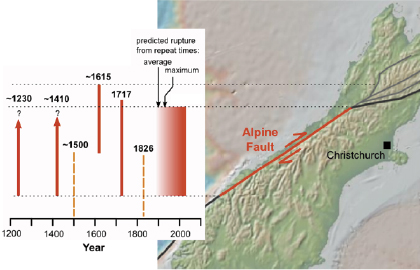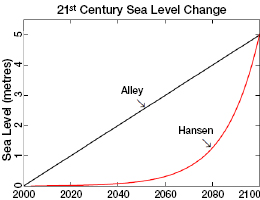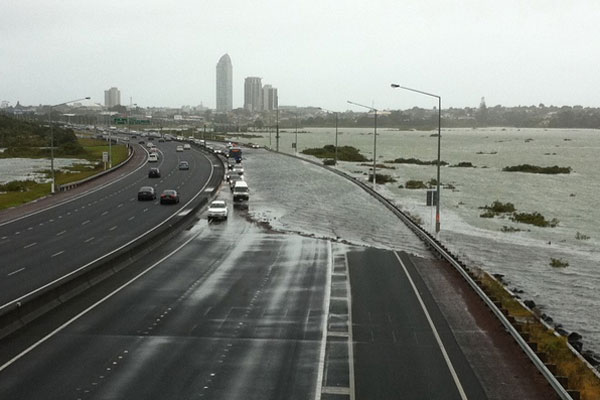Better place for cathedral closer to Alpine Fault
Updated 4 September 2011

Learning From History: While the Wellington Fault will possibly not rupture for 600 years, the Alpine Fault could be considered considerably overdue. infographic Highly Allochthonous
The Alpine Fault doesn’t move 30 millimetres every year. It does on average, but the fault hasn’t ruptured since 1717.
If goes anytime soon, nine metres of pent up horizontal movement could be released in an earthquake of a magnitude of more than eight.
While that might not sound formidably large, only six earthquakes have ever been recorded at greater than eight. And if it were an 8.5 magnitude event, it would unleash two thousand times the energy of the 22 February 2011 Christchurch Earthquake.
The previous Alpine Fault events were in 1615, 1410 and 1230. Along with the last one, which was 294 years ago, this is an average repeat time of 160 years. As geologist Dr Chris Rowan puts it:
The math is hardly reassuring, is it?
In contrast, if the Wellington Fault ruptured tomorrow, it could be considered 600 years early. It is now understood to produce a major event every 900 years, and to have last ruptured 300 years ago. That is not to suggest fault-straddling Wellingtonians need not be vigilant—even a minor jolt could prove deadly.
The shallowness of Tuesday’s killer quake, and it being centred so close to Christchurch’s central business district was just one of the reasons 181 people died: Liquefaction was a major factor.

Unlikely to be Linear: Five-metre sea level change this century under assumption of linear change (Alley, 2010) and exponential change (Hansen, 2007), the latter with a 10-year doubling time. Paleoclimate Implications for Human-Made Climate Change James E Hansen and Makiko Sato
It used to be a point of pride that the city had been built where once was swamp—maps highlighting Canterbury soils prone to liquefaction are pretty much a map of Christchurch. Although liquefaction is most visible in the suburbs, it doesn’t need to bubble to the surface to have a devastating impact on buildings. Liquefaction can magnify the shake of an earthquake, by momentarily turning the ground under central city buildings to jelly. The city could anticipate a better future if its business district was re-built closer to the Alpine Fault.
There is, of course, an even more compelling imperative for the future business district of Christchurch to be located well west of the soils prone to liquefaction. By the end of this century, the probable multi-metre rise in sea level will likely have Cathedral Square awash, and be rising at the rate of five metres per decade.
This suggests that the business district should be relocated about 10 kilometres west of the airport, which itself may not be inundated until the 2130s.
The vast majority of the world’s cities began life as, or near, seaports. These now all need to migrate inland. Christchurch at least has readily available options. In contrast, about the same time Christchurch Airport is awash, the Tamaki isthmus will have morphed into the Makaurau Strait, dotted with the islands Motukiekie, Motuwhau, Motureipae, Motumangere and others, once-named One Tree Hill, Mount Eden, Mount Wellington and Mangere Mountain.

Work Cut Out: Without beginning any unnecessary works, the New Zealand Transport Agency has its time cut out keeping ahead of sea level rise. Some 170 millimetres of the storm surge that covered the southbound lanes of Makaurau’s northern motorway on 23 January is attributable to anthropogenic global warming. photograph @ShotbyRobins
The cost of moving the metropolis will dwarf the $20 billion job of rebuilding Christchurch. However, a considerable difference is that Makaurau, by prioritising low-lying areas such as the waterfront and Mangere—both the suburb and international airport—can span its relocation over the course of a century.
While the New Zealand Transport Agency no doubt continues to sink money into planning a Pūhoi–Wellsford motorway, the cost of rebuilding Christchurch will likely ensure that physical work on the antediluvian project never begins. Aside from the self-evident need for the agency to heed its mission of building a better transport system for New Zealanders, the cost of staying ahead of sea level rise will consume an ever-increasing proportion of its budget.
It would be wholly unwise to rebuild the cathedral and business district on shaky ground, being made increasingly shaky by the inexorably rising water table—ahead of wholesale sea level rise.
It is natural to treat the carnage in Christchurch as a test of character, but it is also a test of wisdom.
Warming last straw To the list of factors involved in the fiendishly complex science of earthquake prediction, anthropogenic global warming can now be added. Ice sheet melt reduces pressure on some parts of the earth’s crust, while sea level rise increases it in other places—both will trigger seismic action. Researchers have linked the El Niño –induced rise in local sea level, of a few hundred millimetres, with increased 4–6 magnitude earthquakes in the Easter Island microplate. As Bill McGuire of University College London told the New Scientist:
You don’t need huge changes to trigger responses from the crust—the changes can be tiny.

I found your excellent site from the following post: Christchurch and The Emperor’s Clothes – Some Harsh Realities
The post noted: Better Place for Cathedral Closer to Alpine Fault and Dr James Hansen Unleashed on Auckland are two recent pieces I published in the Mahurangi Magazine.
The former was in the context of a vary rare airing of the question: Should the Christchurch CBD be rebuilt where it stands, given that Cathedral Square lies between five and six metres above sea level? This article no longer seems to exist on this site. Can you explain where I can find it, and I’d incidentally be interested to know why it was moved or withdrawn. There seems to be a perplexing veil of silence associated with this topic; it does not even rate a mention in the master plan for the rebuild, despite a whole section on long-term issues for the city. Having lived in Christchurch all my life I do not want to contemplate the unthinkable implications of sea-level rise for the rebuild, but sticking my fingers in my ears and chanting ‘la la la’ does not seem a very adult alternative.
Abject apologies!
The file extensions of those two pieces changed when comments functionality was added to the site. Links [are now]: https://www.mahurangi.org.nz/2011/03/02/closer-to-alpine-fault/ and https://www.mahurangi.org.nz/2011/03/26/unleashed-on-auckland/
I suspect the veil of silence regarding sea-level rise is due to the collective la-la-la-ing.
Thank you for your kind words for the Mahurangi Magazine.
Links above updated, subsequent to my darling daughter, the site architect and webmaster Tira Cole, building this handsome new site and migrating more than 600 articles and 4400 links, to it.